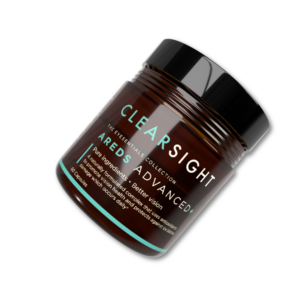Age-related macular degeneration (AMD) affects millions worldwide, causing vision loss in people 50 and older. Making AMD the leading cause of Vision Loss. Understanding the causes and available treatments is imperative for those at risk.
Age-related macular degeneration (AMD) is a significant cause of severe vision loss, predominantly among those over 60. The disease’s hallmark is its impairment of central vision, vital for reading or driving, while typically sparing peripheral vision. Age-related macular degeneration, or AMD, is classified into dry and wet forms. Dry macular degeneration form is more common and progresses slower, whereas wet macular degeneration is less common but advances quicker with abnormal blood vessel growth, leading to central vision loss.
Age-related eye Disease Studies (AREDS and AREDS2) identified beneficial dietary supplements for those with intermediate to late-stage dry AMD, revealing that a blend of specific vitamins and minerals can decelerate the advancement of the disease. Risk factors for this condition encompass genetic elements, race, with a higher incidence in Caucasians, and lifestyle choices.
Routine dilated eye exams are pivotal for early detection. While there is no cure, treatments aim to slow progression and include a range of approaches, from pharmaceuticals to laser therapy. To mitigate AMD risk factors effectively, maintaining a healthy weight and diet is advised. The National Eye Institute further suggests implementing lifestyle changes to foster overall eye health.
| Risk Factor | Impact on AMD |
|---|---|
| Genetics | High |
| Race (Caucasians) | Higher risk |
| Smoking | Doubles risk |
| Diet | Variable impact |

Dry AMD, which progresses through early to late stages, might initially cause no symptoms. As it advances to intermediate, sufferers may need more light when working up close, experience blurred print, perceive colors as dull, and notice a blurred or hazed spot in their central vision. These signs can notably impair tasks like reading or recognizing faces.
Wet AMD, is marked by the growth of abnormal blood vessels under the macula and can present a range of symptoms, including distortions where straight lines appear wavy, objects looking smaller or more distant, and a sudden loss of central vision. This form may also lead to a quick onset of a central visual blind spot.
| Stage | Dry AMD Symptoms | Wet AMD Symptoms |
|---|---|---|
| Early | Seldom any | N/A |
| Intermediate | Blurriness, difficulty seeing in low light | N/A |
| Late | Hazy/Blurred central vision, need for light, faded colors | Straight lines wavy, size distortion, sudden central vision loss, blind spot |
Paying attention to these symptoms is crucial, emphasizing the need for regular check-ups for a timely diagnosis and effective management of AMD.
An often-overlooked symptom associated with vision loss from wet AMD is the potential for visual hallucinations known as Charles Bonnet syndrome (CBS). Up to half of those with vision loss from macular degeneration may experience this unsettling phenomenon, further highlighting the complex implications this disease has on a person’s life.
Early detection of macular degeneration is imperative for managing the condition and potentially slowing its progression. Diagnosing wet and dry age-related macular degeneration (AMD) involves thorough and comprehensive eye examinations by an optometrist or ophthalmologist. In order to detect changes that might signal the onset of macular degeneration, healthcare professionals look for key symptoms such as distortions in vision, the presence of wavy or crooked lines, changes in clarity of color vision, or noticing a dark or empty area in the center of one’s visual field.
Part of the diagnostic process may also include utilizing an Amsler Grid, a simple screening tool that individuals can use at home. This grid helps to identify vision irregularities that may point towards AMD. Recognizing symptoms early on makes managing macular degeneration more effective, even though there is currently no cure. Treatments available are intended to slow down its progression and help patients maintain as much of their existing vision as possible.
To confirm a suspected case of macular degeneration, various eye exams and tests may be administered. During a routine eye examination, a patient undergoes a retinal exam. This is a crucial part of the evaluation process, where an eye doctor may identify drusen, which are yellow deposits that form beneath the retina. Drusen is often a common sign of AMD.
Patients may be provided with an Amsler Grid for home screening purposes. Regular use can reveal important warning signs of AMD, such as distortion in the grid’s lines that might signify changes in central vision.
In certain cases, diagnostic angiography might be employed to diagnose the wet form of AMD. This test is designed to provide a detailed view of the macula and can reveal leaking from the abnormal blood vessels associated with wet AMD.
Dilating eye drops might be used to obtain a clearer view of the retina and the eye’s internal structures. These drops enlarge the pupils during the examination, aiding in the facilitation of a diagnosis and allowing a detailed assessment of the health of the eye’s interior parts.
| Eye Test/Exams | Purpose |
|---|---|
| Retinal Exam | To look for drusen and changes in the retina |
| Amsler Grid | For at-home screening of vision changes |
| Diagnostic Angiography | To examine the macula closely for signs of wet AMD |
| Dilated Eye Exams | To provide a detailed view of the eye’s internal structures |
Consistent check-ups are essential to tracking the condition’s development, as AMD can cause severe vision loss if it progresses to its advanced stages. These specialized examinations not only assist in diagnosing AMD but also in crafting a tailored treatment and monitoring plan.

Although there is no known cure for macular degeneration, several treatment options are available that aim to slow down the progression of the disease and preserve as much vision as possible. The treatment course chosen will depend on whether the patient has the dry or wet form of age-related macular degeneration (AMD).
Managing dry age-related macular degeneration (AMD) primarily includes lifestyle modifications and nutritional supplements as supported by the Age-Related Eye Disease Studies (AREDS and AREDS2). The regimen recommends a combination of vitamins C and E, lutein, and zinc, which has been shown to slow disease progression. Currently, no direct treatments are available for most dry AMD cases, except for a subtype known as geographic atrophy. For this condition, recently developed medications like pegcetacoplan and avacincaptad pegol offer some hope. These treatments, when available, are typically administered via injections into the eye and work to slow atrophy progression, which can delay related vision loss.
As of now, no treatment exists for drusen, the yellow deposits that are a hallmark of dry AMD. Therefore, the focus is on lifestyle adjustments and vitamin supplementation to obstruct progression rather than reverse existing damage.
Wet AMD presents more aggressive treatment options due to the nature of its progression, which involves abnormal blood vessels that can leak fluid or bleed, causing rapid and severe vision loss. The cornerstone of wet AMD treatment involves the use of anti-vascular endothelial growth factor (anti-VEGF) injections. These drugs, such as aflibercept (Eylea®), ranibizumab (Lucentis®), and bevacizumab (Avastin®), target the VEGF protein that stimulates the growth of abnormal blood vessels in the eye.
Laser surgery is another treatment method used for wet AMD, employing a focused beam of light to eliminate the problematic vessels. Additionally, photodynamic therapy involves a light-sensitive medication that becomes active under laser light to close off leaking vessels.
Patients with wet AMD may also benefit from low-vision aids and therapy, which can help them better utilize their remaining vision and improve their quality of life. These supportive methodologies are crucial in helping patients adapt to changes in their vision and maintain independence.
Nutritional supplements play a noteworthy role in managing dry AMD and can be beneficial in reducing the risk of advanced disease progression. The AREDS formula, refined through the AREDS2 study, suggests that a combination of high doses of antioxidant vitamins (C and E), along with zinc, copper, lutein, and zeaxanthin, could slow down the progression of the disease in high-risk patients. Additional dietary inclusion of omega-3 fatty acids from sources such as fish and walnuts is also suggested to potentially decrease the risk of AMD.
These supplements are not a cure but can assist in managing the condition. AREDS 2 supplements can contribute to maintaining visual function and slowing the progression of macular degeneration.
| Supplements | Role in AMD Management |
|---|---|
| Antioxidants (Vitamins C and E) | May slow disease progression |
| Zinc and Copper | Essential for retinal health, may reduce risk of advanced AMD |
| Lutein and Zeaxanthin | May slow progression and reduce risk of vision loss |
| Omega-3 Fatty Acids | Advised for inclusion in diet to potentially reduce risk of AMD |
Maintaining optimal eye health includes taking proactive steps to safeguard your vision, especially as you age. Regular comprehensive eye exams are fundamental for early detection of macular degeneration, allowing for the timely initiation of treatments that can slow its progression. Understandably, while these treatments may preserve the existing vision, they’re limited in their ability to restore any vision that’s already lost.
Implementing a series of lifestyle changes can play an essential role in reducing the risk of developing age-related macular degeneration (AMD). Such changes include quitting smoking, which has been identified as a significant risk factor for AMD.
Using UV protective eyewear is another preventive measure that shields the eyes from harmful ultraviolet rays, which can exacerbate eye damage. Additionally, maintaining cardiovascular health through regular exercise and effectively managing other health conditions such as diabetes and hypertension is recommended as a comprehensive approach to prevent the onset of macular degeneration.

A natural approach to preventing the progression of age-related macular degeneration emphasizes the critical role of diet and lifestyle. An antioxidant-rich diet, abundant in fruits and vegetables, may lower the risk of developing AMD.
In terms of diet, the inclusion of antioxidant-rich fruits and vegetables can contribute to eye health. Omega-3 fatty acids, commonly found in fish and nuts, are also associated with a lower risk of AMD. Age-related eye Disease Studies indicate that adopting a diet or supplement regime containing lutein, zeaxanthin, vitamin C, vitamin E, and zinc can potentially reduce the risk of progression in high-risk individuals.
Staying physically active and maintaining a healthy weight are additional preventative measures that can decrease the risk of macular degeneration and promote overall eye health.
Managing systemic health conditions such as hypertension is also advised to mitigate the risk associated with macular degeneration. Optimal control of blood pressure can help stabilize the delicate blood vessels in the eye, therefore decreasing the chance of developing AMD.
| Lifestyle Change | Benefits in AMD Prevention |
|---|---|
| Regular Eye Exams | Early Detection |
| Quit Smoking | Reduces Risk of AMD |
| Healthy Weight & Exercise | Reduces Risk & Slows Progression |
| Diet (Antioxidants & Omega-3s) | May Lower the Risk of AMD |
| UV Protective Eyewear | Shields Eyes from Harmful UV Rays |
| Blood Pressure Control | Stabilizes Retinal Blood Vessels |
By intertwining these natural prevention strategies within daily life, individuals can support their eye health and potentially reduce the risk of age-related macular degeneration.
When Macular degeneration progresses to the advanced wet form, it can have profound implications on an individual’s vision and, consequently, their quality of life. Central vision becomes blurred or, in some cases, may be entirely lost, drastically affecting the ability to perform daily tasks that rely on sharp vision, such as reading or recognizing faces. This central vision loss can occur rapidly if the condition transitions from dry to wet macular degeneration and is not treated quickly.
Despite the severe nature of the vision loss, total blindness is rare in those affected by macular degeneration since peripheral vision is typically preserved. However, even with peripheral vision intact, the reduction of central vision can lead to increased difficulties with daily activities, which can in turn elevate the risk of depression and social isolation among sufferers.
| Vision Impairment | Daily Task Affected |
|---|---|
| Blurry Central Vision | Reading, Writing |
| Loss of Central Vision | Recognizing Faces, Driving |
| Peripheral Vision Retained | Overall Visual Navigation |
Age-related macular degeneration (AMD) insidiously impairs central vision, which is crucial for sharp, detailed activities like reading, driving, and recognizing fine details.
Those with advanced AMD may notice a distinct blurry or blind spot in their central visual field, making straight-ahead vision increasingly imprecise. Fortunately, while AMD can severely impair one’s sight, it typically does not result in complete blindness, as peripheral vision remains unaffected.
Even when an individual’s central vision is severely compromised and they are deemed legally blind, assistive visual devices such as eyeglasses, contact lenses, specialized lighting, or magnification tools can sometimes provide substantial improvements in vision, enabling better management of daily activities.
List of Assistive Devices for AMD:
Living with AMD may be challenging, but understanding that there are tools and resources available can empower those affected, enabling them to maintain some degree of autonomy and visual functionality.
The impact of age-related macular degeneration (AMD) on quality of life extends beyond the visual symptoms it can lead to psychological and emotional strain for many. AMD stands as the most common cause of sight loss, especially impacting those over 55. This vision loss can challenge one’s independence by complicating everyday activities like reading street signs or managing household tasks.
Mood disorders such as depression are prevalent among individuals with AMD, with as many as 39% of patients experiencing depressive symptoms alongside anxiety, which further exacerbates the impact on quality of life. As the condition progresses, sight-dependent tasks such as driving may become more challenging, sometimes requiring individuals to undergo regular vision assessments to ensure they are fit for the road.
| Lifestyle Changes | Impact on AMD Management |
|---|---|
| Quitting Smoking | Reduces Progression Risk |
| Nutrient-Rich Diet | Supports Eye Health |
| Exercise | Promotes Vascular Health |
| Healthy Weight | Alleviates Extra Stress on the Eyes |
Understanding and addressing AMD’s multifaceted effects on vision and overall quality of life are essential for patients to live as fully and independently as possible. With proactive management and support, individuals with AMD can navigate the complexities of the condition with greater confidence and resilience.
The fight against macular degeneration has seen significant advancements in recent years, with researchers tirelessly pursuing better treatments and the possibility of a cure. As the scientific community deepens its understanding of the disease, innovative therapies and preventative strategies emerge, offering hope to those affected.
Photodynamic therapy, notably involving verteporfin, represents a remarkable leap forward. Administered to patients with the wet form of age-related macular degeneration (AMD), verteporfin is activated by laser light, targeting and obliterating the abnormal blood vessels that characterize this type of macular degeneration. This treatment aims to prevent further damage to the macula and preserve the remaining vision.
Beyond established therapies, the surgical frontier is being explored with procedures like submacular surgery and retinal translocation. Both of these experimental treatments focus on addressing the abnormal vessels directly or repositioning the macula for improved function, respectively.
The connection between systemic health and AMD has also garnered attention, with cardiovascular disease risk factors being implicated in the progression of macular degeneration. Further study into these associations could unlock new avenues for prevention and treatment.
Underscoring these medical interventions are the findings from the Age-Related Eye Disease Studies (AREDS/AREDS2), which have significantly influenced our approach to AMD management. These landmark studies have provided clear evidence that specific vitamins and minerals can help slow the disease’s progression, offering an accessible form of intervention for those at risk of vision loss.
The American Macular Degeneration Foundation continues to champion research efforts, supporting projects that investigate not only the medical aspects but also the improvements in quality of life for those living with AMD.
Studies in the realm of AMD are constantly yielding insightful revelations. The use of high-energy laser light and photodynamic therapy with verteporfin has proven useful in curbing the growth of detrimental blood vessels in the eye. Concurrently, exploratory treatments such as submacular surgery and retinal translocation are under rigorous investigation, promising to reshape the therapeutic landscape.
Nutritional science has also provided a better grasp of how diet influences AMD. A meta-analysis of cohort studies emphasizes the relationship between fatty acid intake and AMD risk, reinforcing the importance of dietary choices. In line with this notion, the Alienor Study highlighted the potential protective impact of dietary omega-3 fatty acids against age-related maculopathy, suggesting that simple nutritional interventions could have profound effects.
These insights are further enriched by contributions from entities like the Age-Related Eye Disease Study Research Group, whose work continues to elucidate the intricacies of age-related eye conditions, enabling more precise and personalized approaches to care.
Looking forward, we can see promising advancements in treating AMD on the horizon. Stem cell research spearheaded by teams at the National Eye Institute (NEI) has shown the ability to repair eye damage in animal models of dry AMD, paving the way for clinical trials in humans.
Emerging medications such as pegcetacoplan and avacincaptad pegol offer new mechanisms of action, targeting geographic atrophy in dry AMD. These injectable therapies aim to decelerate the atrophy, thereby preserving vision for longer periods.
The established research of AREDS and AREDS2 continues to influence treatment. AREDS2 endorses a combination of vitamins and minerals that can arrest the progression of dry AMD, especially in individuals with certain levels of drusen or who suffer from severe vision loss.
A mainstay of current treatment, intravitreal injections of anti-VEGF medication, has dramatically improved the prognosis for people with AMD. This approach has proven superior to laser therapy, enhancing visual acuity and overall patient quality of life.
While a definitive cure for AMD remains elusive, these treatments represent significant strides in managing symptoms and conserving vision, maintaining hope for millions impacted by this condition.

Discover the transformative effects of Clearsight AREDS Vision Supplement. Crafted with vital nutrients, it offers protection and improvement for your eyesight, targeting age-related vision problems. Experience enhanced eye health and clearer vision with regular use.
Subscribe to our newsletter for wellness tips, special offers and an instant $10 discount on your first purchase!
Sign Up now and receive 15% off your first order